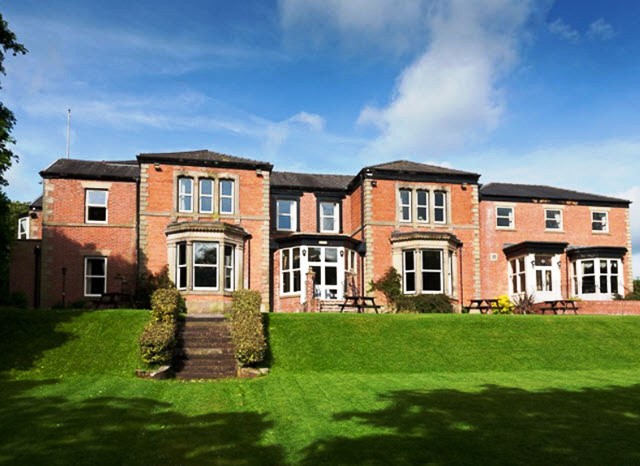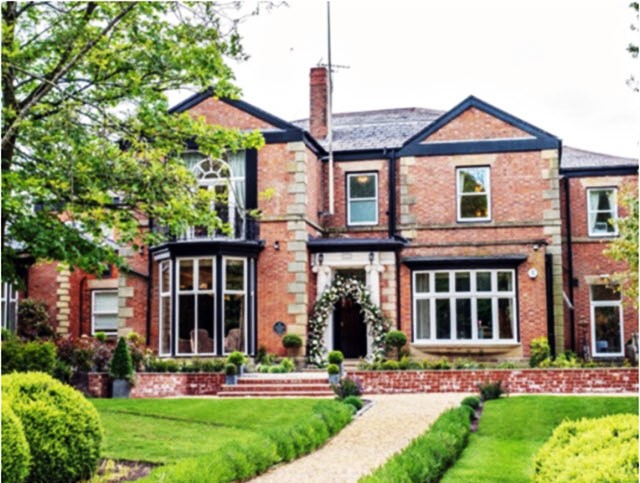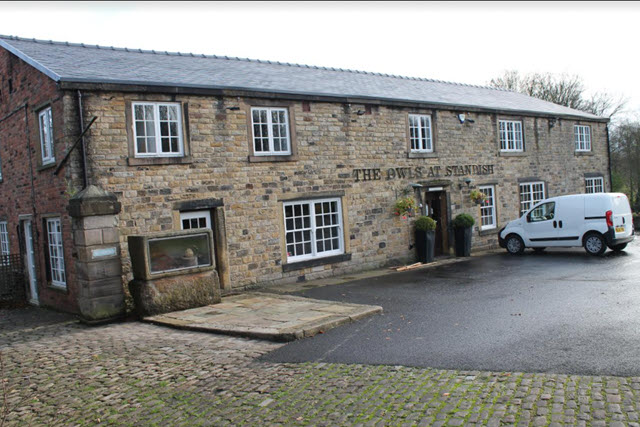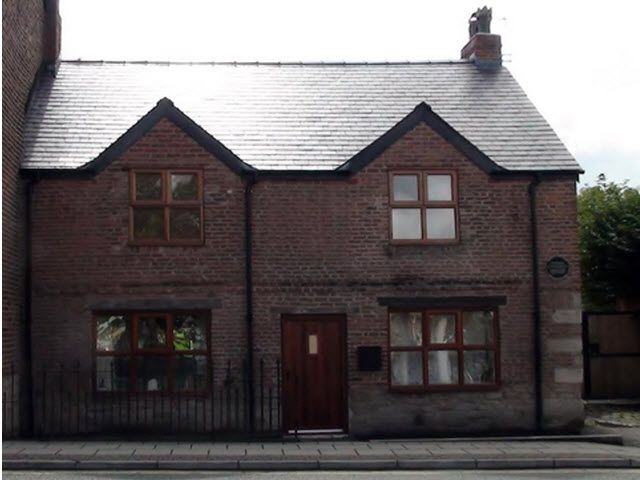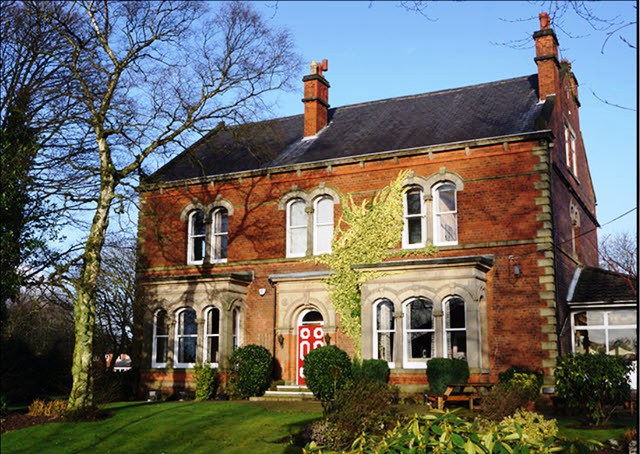Ashfield House
Ashfield Park Drive, WN6 0EE, Standish
Part of Group:
At Risk: No
Description
Ashfield House is an elegant English Country House standing in its own landscaped grounds. Built on land called Ashfield in 1755 by Felix Leach (founder of the Crawford business in Wigan), it was enlarged in 1872 by John Lancaster the then Liberal MP for Wigan.
The building became the offices of Standish Urban District Council and closed in the 1970's.
Currently, a very nice hotel and wedding venue.
The house was the home of three people, Maskell William Peace, John Lancaster, and James Carlton Eckersley, who were all instrumental to the industrial success of Wigan in Victorian times.
Below are the obituaries for William Maskell Peace, John Lancaster and James Carlton Eckersley
Makell William Peace. (Obituary)
MASKELL WILLIAM PEACE, who died at Southport on 9th November 1892, was the son of the late Mr. William Peace, who was formerly the mineral agent for the late Earl of Crawford.
He was born in Wigan on 3rd April 1834, was educated at Rossall School, and, on leaving that establishment, was articled to the late Mr. John Mayhew, solicitor, of Wigan. On completing his articles, Mr. Peace was admitted a solicitor in Trinity Term 1855, and commenced business on his own account in an office in Standishgate, Wigan. Subsequently he removed to 10 King Street, and having taken into partnership Mr. Herbert Booth Bell, the firm was carried on under the style of Peace & Bell. This partnership was dissolved after a few years, on Mr. Bell removing to London. Mr. Peace then entered into partnership with Mr. Henry Ackerley of Wigan, and Mr. William Appleton of Oswestry, and this partnership was carried on under the style of Peace, Ackerley & Appleton, at Leader's Buildings, King Street. Mr. Appleton shortly afterwards retired from the firm, and the business was conducted under the style of Peace, Ackerley and Co. About 1883 this partnership was dissolved, and Mr. Peace joined Mr. Thomas Ratcliffe Ellis, the surviving partner of the firm of Scott and Ellis, ant the combined businesses have since been carried on under the style of Peace & Ellis.
Mr. Peace held numerous public appointments, and filled them with ability. His services as secretary of the Wigan Mining and Mechanical School, from its foundation in 1858 to the present time, will long be remembered in the local history of technical education. He was appointed law clerk and secretary of the South Lancashire and Cheshire Coal Association on the 3rd April 1861, and acted in that capacity up to the time of his death. He was appointed solicitor to the Mining Association of Great Britain in February 1866, becoming secretary of the Association in February 1870, and he acted as law clerk and secretary up to the time of his death.
He was for many years identified with the municipal life of Wigan, first as a councillor, and subsequently as town clerk — a position he filled for a period of more than eighteen years, viz., from 24th September 1866 to 31st March 1885. On the occasion of his retirement from this office, he was presented by the members of the Town Council, and the leading officials of the Corporation, with a beautiful piece of plate and an illuminated address. He was shortly afterwards appointed an alderman of the borough, and was more than once invited to accept the Mayoralty, which he was compelled to decline owing to the state of his own and of his wife's health. On the day of his death he was appointed returning alderman of one of the wards, and his name was placed on several committees. He represented Wigan on the County Joint Committee to enforce the provisions of the Rivers Pollution Prevention Act, 1876, in relation to the river Ribble. He was returned unopposed to the Lancashire County Council as the first Councillor representing the Standish Division, and, on his term of office expiring, was again elected without opposition. He was also appointed Chairman of the Parliamentary Committee of the Council, a position which his abilities and reputation eminently qualified him to fill.
Mr. Peace was the author of several books relating to mining law, and his works on the Coal Mines Regulation Acts and the Truck Acts were accepted as authorities on these subjects. On all questions affecting the law of minerals he was an admitted authority, whilst on questions arising on Private Bills in Parliament his opinion was frequently sought in the interests of coalowners, property owners, and traders generally, with the view of obtaining protective clauses. In connection with the Railway and Canal Traffic Act, 1888, Mr. Peace was actively engaged, as representing the Mining Association, on the Board of Trade inquiry into the revised schedules and classifications of the various railway companies, and, subsequently, on the inquiry before the Joint Select Committee of Lords and Commons on the Provisional Order Bills which were brought in to confirm those schedules. Mr. Peace was engaged up to the time of his death in the Board of Trade inquiry into the revised schedules of the various canal companies, and railway companies owning canals. As a conveyancing lawyer, particularly as regards mining leases, he was also an authority. He was the Secretary to the Board of Examination for mine managers certificates for the districts of North and East Lancashire and. Ireland, and West Lancashire and North Wales. He was appointed solicitor and secretary to the Lancashire and Cheshire Coalowners' Defence Association on the establishment of that organisation in June last.
At the last annual meeting of the Manchester Geological Society, Mr. Peace was appointed President of that body for the ensuing year. Amongst his numerous other appointments he was the solicitor for the Lancashire and Cheshire Miners' Permanent Relief Society, the Central Association for dealing with Distress caused by Mining Accidents, and the Colliery Managers' Association, while in addition to his public appointments, he was the secretary of the Wigan Coal and Iron Company, Limited, from the beginning of 1870, as well as secretary to the Cossall Colliery Company, Limited, Nottingham, since its formation in 1877, and to the Colliery Guardian Company, Limited.
Mr. Peace was a prominent Freemason, and when the Volunteer movement was originated in the Wigan district, he interested himself in connection with it, and was appointed Lieutenant of the Haigh corps. He had been a member of the Iron and Steel Institute since 1876.
Source; 1892 Iron & Steel Institute
John Lancaster - Obituary
JOHN LANCASTER, who died September (sic) 21, 1884, was born at Radcliffe, near Bury, Lancashire, on September 19, 1815, and was one of seven sons of Mr. John Lancaster, of that place.
From a very early age he showed an enthusiastic liking for mechanics and mining engineering, and when about twenty years of age he and his brother bored for coal on Chat Moss.
In 1841 he projected and carried on the sinking of the colliery at Patricroft through the Permian formation, when coal was cut at a depth of 440 yards. This colliery was worked by his father and partner for several years, and during its whole life the deceased had its practical management. Whilst engaged with this colliery he projected the lower cannel pits at Ince-in-Makerfield, along with Mr. H. King, of Rochdale, about the year 1844. The lower cannel pits were sold in the year 1845 to. the present Ince Hall Coal and Cannel Company.
In the year 1845 Mr. Lancaster started the Kirkless Hall Company, Aspull, and there laid the foundation of that great concern—the Wigan Coal and Iron Company—which has since developed into one of the largest mining companies in the kingdom.
In the year 1847, Mr. Lancaster became mineral agent to Lord Mostyn at Mostyn Colliery, Flintshire, and continued to fill that post for several years.
From 1849 to 1856 he had the management of Earl Granville's ironworks and collieries, Shelton, North Staffordshire, and he erected the Shelton Bar Ironworks, in which Earl Granville is and was from the first largely interested.
In 1855 he took charge of sinking a new colliery at Shireoaks, near Worksop, 520 yards deep, for the Duke of Newcastle. This colliery was completed in 1858, and has been, and still is, very successfully worked by a company, which bought, it and leased the mines from the Duke. In the year 1858 Mr. Lancaster and his partners built the Kirkless Hall Ironworks. Five furnaces were built from 1856 to 1860, and they were the first erected in Lancashire, with the exception of two small charcoal furnaces at Ulverston. The Kirkless Hall Works have been extended from time to time until they now comprise ten blast furnaces.
In 1865 the Wigan Coal & Iron Company was formed, with a capital of over two millions, by an amalgamation of the collieries belonging to and worked by the Earl of Crawford and Balcarres and the collieries and ironworks carried on by Mr. Lancaster and his partners. The concerns taken over were the Haigh and Holland Collieries, the Kirkless Hall Collieries and Ironworks, the Standish and Shevington Cannel Works, the Broomfield Colliery, and the pits worked by Mr. J. Taylor under the style of the Standish Coal Company. Mr. Lancaster was appointed the first chairman, and he continued his connection with the concern until 1870, when, owing to certain differences, he withdrew from the company. From that time until his death he was chairman of the West Cumberland Iron and Steel Company. He was also a partner in the Eldon Colliery, Durham; the projector and the chairman of the Bestwood Coal and Iron Company, near Nottingham; and a partner in the Nant-y-Glo and Blaina Collieries, South Wales.
Mr. Lancaster took an active interest in railway development. As chairman of the Lancashire Union Railway Company he rendered services to the coal trade of that county which were recognised in August 1865 by the presentation to him of a service of silver plate, for the purchase of which over £400 was raised by public subscription.
One of the most notable events in the career of the deceased gentleman was his rescue, on the 19th June 1864, of the captain and crew of the Alabama, after the fight between that well-known Confederate .cruiser and the Federal war-steamer Kearsage. On the 25th March 1866 Mr. Lancaster was returned as member of Parliament for Wigan, and sat for that constituency until 1874, when be was opposed and defeated. He was placed on the Commission of the Peace for the county of Lancaster in 1865, and shortly afterwards he was appointed Deputy-Lieutenant for Warwickshire.
Mr. Lancaster was an original member of the Institute, and had acted on the Council from 1870 until the time of his death. He was a tolerably regular attender at the meetings of the Institute, and occasionally took part in debate. He was also a member of the Institution of Mechanical Engineers, a member of the Board of Management of the British Iron Trade Association, and a member of Council and past-President of the Mining Association of Great Britain.
He married, in 1841, Euphemia, eldest daughter of Mr. Gibson, of Johnstone, near Glasgow, who predeceased him.
Source: 1884 Iron & Steel Institute
John Lancaster was one of the prime movers in establishing the Wigan Infirmary which opened in 1873.
James Carlton Eckersley JP
Obituary (1854-1926)
We regret to announce the death of Mr. James Carlton Eckersley, M.A., J.P., of Carlton Manor, Yeadon, near Leeds, which occurred on Sunday at his London residence of 22 North Audley Street, at the age of 71 years.
The deceased gentleman, who was the eldest son of the late Mr. Nathaniel Eckersley, formerly Conservative M.P. for Wigan, and a well-known Wigan colliery proprietor, cotton master and banker, was born at Shelley House, Pemberton, where his father formerly resided. Later, his father and the family for over thirty years resided at Standish Hall, and afterwards the deceased for a long period made his home at Ashfield House, Standish, until about eighteen years ago when he went to reside at Carlton Manor estate on the death of his father, which occurred in 1892.
After being educated privately, Mr. Eckersley was at Oxford University, and on taking up residence in the Wigan district, he interested himself keenly in local church affairs and educational work. He was appointed County Magistrate in 1882. He was made vice-president of the Wigan Infirmary, and chairman of the Hindley Library Committee, and vice-president of the Wigan Conservative Club. The Poolstock Schools were built in 1851 by the late Mr. James Eckersley, the uncle of the deceased, and his father Mr. Nathaniel Eckersley. The latter gentleman founded St James Church in Poolstock in 1863. The consecration taking place in 1866, the same year that he was elected M.P. for Wigan. The deceased maintained the family interest in the Church and the Schools at Poolstock. The schools, in fact, remaining his own property until last year, when he sold them to the church officials for a nominal fee, an act of generosity, which was greatly appreciated. In various ways, the deceased was a generous benefactor to Poolstock Church and Schools and to many other churches and schools in the Wigan District, the last example of his work in this respect being in connection with St Peter’s Church, Hindley, and St. Nathaniel’s Church, Platt Bridge. At the time of his death, he was a trustee in St Peter’s Church, and the family associations with the church dated back many years, his father having been one of the first church trustees when St Nathaniel’s was made a separate parish. The deceased gentleman was a most liberal helper, and prior to this, he has assisted in a generous manner in securing the Day and Sunday Schools at Hindley from private ownership. St Nathaniel’s Church was consecrated in June 1905, and the pulpit and pillars in the church were the gift of Mr. Eckersley, who continued for many years to afford generous support for the new parish. He also contributed generously towards the building of St Paul’s Church, Goose Green, and he was the patron of the living of St James in Poolstock.
The most important aspect of his educational work was in connection with the Hindley and Abram Grammar School, which he was instrumental in placing the firm position, which it occupies today. It was almost entirely due to his generous support that the school has such up-to-date and handsome buildings for when Mr. Eckersley first became associated with it. The school premises comprised one room and one schoolroom and there were only some thirty-six scholars. It was Mr. Eckersley who built the extensions in 1903, and it was largely due to his efforts that the school received recognition by the County Authorities and the Secondary School. Mr. Eckersley completed the extension in 1909 at a cost of some £6,000, and he provided the heating apparatus and equipment. He also endowed several scholarships. Since 1887, he had been chairman of the Governors of the school, and retained this position up to the time of his death.
Mr. Eckersley was a member of the Liverpool Cathedral Building Fund Committee, and he made handsome donations to the Cathedral building fund. Over an extended period, he was partner in Eckersley’s Mills, Poolstock until the Amalgamation in the Cotton Trust a few years ago. While resident in the Standish district he was Rector’s Warden at Standish Parish Church. During his residence at Carlton Manor, he was known as the Squire of Yeadon. The Eckersley family had considerable landowning interests in the Hindley district.
Colonel FF Eckersley, J.P., of Wem, Shropshire, who was Mayor of Wigan in 1893, is the only surviving brother of the deceased.
THE FUNERAL
The funeral took place at Standish Parish Church on Thursday. The body was brought by road from Yorkshire and was met at Standish by a large number of representatives of public bodies and churches with which the deceased gentleman was associated.
The chief mourner was Colonel Nathaniel Ffarington Eckersley of Wem, brother of the deceased. There were also a number of tenants and members of the household staff from Yeadon.
Clergy from all his church interests, council representation, educational interests etc were all present.

